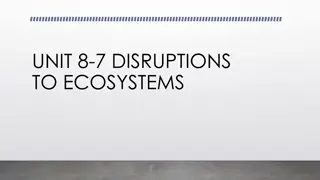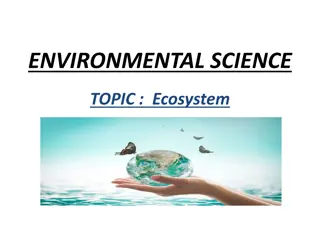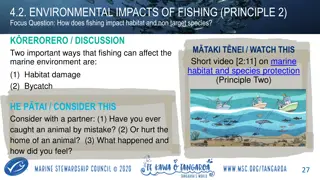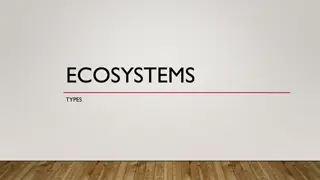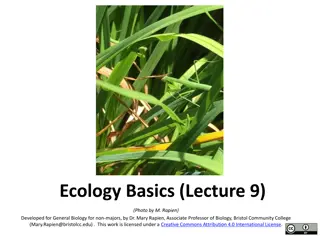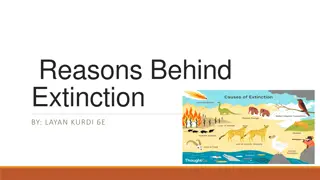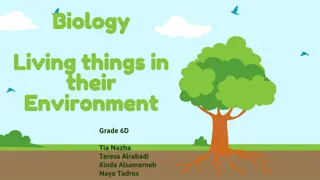Understanding Ecosystems and Habitat Identification Through Practical Activities
Explore the dynamic interaction between organisms and the environment in various ecosystems through practical activities like identifying habitats, fauna, and flora using simple keys. Learn how to use collection apparatus for ecological studies and create keys to classify different objects and organisms. Engage in catching animals and extracting them from soil to deepen your understanding of ecological studies.
Download Presentation

Please find below an Image/Link to download the presentation.
The content on the website is provided AS IS for your information and personal use only. It may not be sold, licensed, or shared on other websites without obtaining consent from the author. Download presentation by click this link. If you encounter any issues during the download, it is possible that the publisher has removed the file from their server.
E N D
Presentation Transcript
Depth of treatment: Identification of a number of habitats from the selected ecosystem. Practical Activities Identify any 5 fauna and any 5 flora using simple keys. Identify a variety of habitats with the selected ecosystem Depth of treatment: Practical Activities Depth of treatment: Identification and application of collection apparatus available for an ecological study. Practical Activities Identify and use various apparatus required for collection methods in an ecological study. Depth of treatment: Practical Activities
Ecosystem v Habitat ECOSYSTEM: Non-living environment + organisms + sun light energy all interacting a dynamic system dynamic system HABITAT: Place where an organism lives Place where an organism lives Ecosystems Hedgerow Woodland Rocky Seashore Grassland Soil Old Wall Ecosystems Habitats Ecosystem) : : o On leaves o In bark o Under old logs o Burrows in ground o On old logs Habitats (in a Woodland
To make a key - Get all the objects/organisms you want to identify together Divide them into 2 groups using visible characteristics and record your dividing parameters e.g. 1. Then divide each group into subgroups again and again and eventually reaching the individual object/organism. 2. Can hold water --- 3. Disc shaped ------ 4. Note that this number can only be inserted after the first half of items have been identified Made with metal ------ Made of paper/card go to 2 go to 5 5 box go to 3 coin go to 4 biro scissors Cannot hold water Long and narrow ---- Cylinder-like shape Two levers ------- 5. Can hold water ---- mug flyer Sits flat on the table --
Check the Key hand and go through each step does it work? Check the Key hold any one of the objects in your 1. Made with metal ------ 2. Can hold water --- 3. Disc shaped ------ 4. Cylinder-like shape ---- 5. Can hold water ---- Now (in pairs) you make a key for the animals on your sheet go to 2 go to 5 5 box go to 3 coin go to 4 biro scissors mug flyer Made of paper/card Cannot hold water Long and narrow ---- Two levers ---------- Sits flat on the table --
Used to extract animals from soil by heating the soil on one side The animals are driven out of the soil by heat from a lamp and fall through a wire gauze 6
Used for catching flying insects. The net part should be sufficiently long so that the mouth frame seals off the end of the net which contains the catch when the net is laid flat. 7
Used to collect insects from tall grass Make sure that length of netting sufficient to allow closure of net with turn of wrist 8
Organisms that live in leaf litter can be extracted by using a sieve with a mesh size of about 5 mm. Use the sieve over a beating tray or a large sheet of paper. 9
This is a white tray, cotton sheet or large sheet of white paper. It is placed under a bush or tree branch. The tree branch is shaken suddenly and vigorously. Insects and other invertebrates fall onto the tray. 10
A piece of wood or stone which is left on the ground. After a suitable interval, animals such as slugs, woodlice, centipedes and millipedes will be found underneath. 11
Used to collect small mammals e.g. mice, voles, etc. 12
Jam jar buried in ground and covered with raised flat stone. Used to collect ground surface animals insects, nocturnal and diurnal e.g. spiders, centipedes, woodlice, beetles, etc. 13
Used for picking up very small animals. Suck through mouthpiece (end of which is covered with muslin) and the animal is taken into jar through the hose 14





